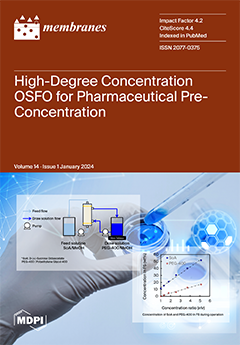A 40 cm length Bis(triethoxysilyl)ethane (BTESE) membrane having different pore sizes was successfully prepared by changing the number of coating times for gas permeation (GP) and organic solvent reverse osmosis (OSRO) separation study. It was found that BTESE-6 membranes prepared through six-time coating consisted of small-sized pores in the range 0.56 to 0.64 nm estimated using modified Gas Translation (mGT) method and 0.59 to 0.67 nm estimated by nanopermporometry (NPP) method, respectively. These membranes demonstrated a high DMF rejection,
RDMF > 95% with total flux,
Jv total > 5 kg m
−2 h
−1 at operating condition feed pressure,
Pf: 8 MPa; feed temperature,
Tf : 50 °C; and feed flowrate,
Qf : 30 mL/min; and they exhibited a high degree selectivity of He/SF
6 in the range of ~ 260–3400 at a permeation temperature 200 °C. On the other hand, the larger pore sizes of the BTESE-4 membranes (pore size estimates > 0.76 nm to 1.02 nm) exhibited low DMF rejection and a low degree selectivity of He/SF
6 around ~30% and 25, respectively, at the same operating condition as BTESE-6. Both GT and NPP methods can be considered as an indicator of the measurement membrane pore size. From this study, it was found that He and SF
6 gases can be some of the potential predictors for water and DMF permeance. Furthermore, by comparing our OSRO membrane with other PV membranes for DMF/H
2O separation, our BTESE-6 membranes still exhibited high flux in the range of 3–6 kg m
−2 h
−1 with a separation factor H
2O/DMF in the range of 80–120.
Full article






